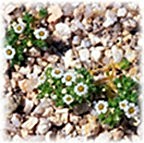San Bernardino Mountain gilia facts for kids
Quick facts for kids San Bernardino Mountain gilia |
|
|---|---|
 |
|
| Scientific classification | |
| Genus: |
Linanthus
|
| Species: |
maculatus
|
Linanthus maculatus is a special kind of flowering plant. It used to be called Gilia maculata. People often call it the San Bernardino Mountain gilia or Little San Bernardino Mountains gilia. This plant is only found in California, which means it is endemic there.
Contents
What is the San Bernardino Mountain Gilia?
The San Bernardino Mountain gilia is a very small plant. It grows for only one year, which means it is an annual herb. It usually grows no taller than three centimeters (about one inch).
Where Does It Live?
This unique plant lives in the dry desert areas of California. You can find it in the Little San Bernardino Mountains. It also grows near Palm Springs in the northern part of the Coachella Valley.
Many of these plants live inside Joshua Tree National Park. Here, you can find thousands of them growing together. They like wide, sandy areas.
What Does It Look Like?
The San Bernardino Mountain gilia has special features that help it live in the desert.
Roots and Stems
It has a long main root called a taproot. This taproot can grow more than six centimeters (about 2.5 inches) deep. It helps the plant find water in the dry desert sand. The plant's tiny stem is covered in small hairs. It branches out to form small, matted groups on the sand.
Leaves and Flowers
The leaves are also very small, only a few millimeters long. They are hairy and do not have any lobes or divisions.
The flowers grow in a tight group. Each flower is tiny, only about 2 to 5 millimeters wide. The petals of the flower curl back. They are usually white, but sometimes they have a spot of purple or pink. The yellow parts that stick out are called stamens. These are important for the plant's reproduction.
Why Is It Important?
The San Bernardino Mountain gilia is a special plant because it only grows in a few places. It is important to protect its habitat.
One big problem for this plant is new buildings and roads. These can take away the sandy areas where it grows. Also, vehicles driving off-road can damage the plants. Protecting these areas helps the gilia survive.

